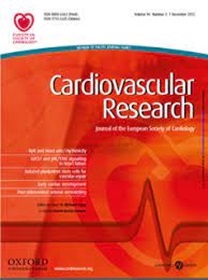Premature cell senescence promotes vascular smooth muscle cell phenotypic modulation and resistance to re-differentiation
IF 13.3
1区 医学
Q1 CARDIAC & CARDIOVASCULAR SYSTEMS
引用次数: 0
Abstract
Aims Human atherosclerotic plaque cells display DNA damage that if left unrepaired can promote premature cell senescence. Vascular smooth muscle cells (VSMCs) predisposed to senescence promote atherogenesis and features of unstable plaques and increase neointima formation after injury. However, how premature VSMC senescence promotes vascular disease and its effects on VSMC phenotype are unknown. Methods and Results Bulk RNA-seq of primary human VSMCs identified 126 significantly up- or down-regulated genes after both DNA damage-induced (D+R) or replicative senescence (RS). Upregulated genes included senescence markers CDKN2A (p16) and ICAM1 and genes expressed by phenotypically modulated de-differentiated/’fibromyocytic’ VSMCs (osteoprotegerin (TNFRSF11B), fibromodulin (FMOD)) as well as transmembrane protein 178B (TMEM178B) and secreted frizzle-related protein 4 (SFRP4). Mouse VSMCs also upregulated genes associated with de-differentiated VSMC phenotype, Tmem178b and Sfrp4 after D+R. Single-cell RNA-sequencing of lineage-traced VSMCs in mouse plaques or human plaques showed that VSMCs expressing Cdkn2a had lower contractile marker expression and higher expression of de-differentiated VSMC markers. Mice expressing a VSMC-restricted mutant telomere protein (TRF2T188A) that induces premature senescence showed increased atherosclerosis, expression of multiple de-differentiation genes in plaques and after injury, and differential regulation of pathways associated with extracellular matrix organisation, inflammation and Transforming Growth Factor-β (Tgfb). Trf2T188A VSMCs were more resistant to re-differentiation and had dysregulated Tgfb signalling at multiple levels with downregulated ligand, receptors, and coactivators and upregulated co-repressor expression. Trf2T188A VSMCs also showed cytosolic DNA and activation of the STING-TBK1-IRF3 pathway that suppressed Tgfb signalling. Silencing IRF3 restored expression of Tgfb pathway components and VSMC contractile markers after TGFb administration. Conclusions DNA damage and senescence induce genes associated with de-differentiated/fibromyocytic VSMCs, and persistence of these cells in vivo. Failure of senescent VSMCs to re-express contractile markers during re-differentiation suggests that VSMC senescence may promote atherosclerosis and neointima formation in part by inhibiting their re-differentiation.细胞过早衰老促进血管平滑肌细胞的表型调节和对再分化的抵抗
目的人类动脉粥样硬化斑块细胞显示DNA损伤,如果不进行修复可促进细胞过早衰老。血管平滑肌细胞(VSMCs)易衰老,促进动脉粥样硬化和不稳定斑块的特征,并增加损伤后新内膜的形成。然而,VSMC过早衰老如何促进血管疾病及其对VSMC表型的影响尚不清楚。方法与结果对原代人VSMCs进行大量rna测序,鉴定出126个DNA损伤诱导(D+R)或复制性衰老(RS)后显著上调或下调的基因。上调的基因包括衰老标记CDKN2A (p16)和ICAM1,以及表型调节的去分化/“纤维肌细胞”VSMCs表达的基因(骨保护素(TNFRSF11B)、纤维调节素(FMOD)、跨膜蛋白178B (TMEM178B)和分泌的卷曲相关蛋白4 (SFRP4))。小鼠VSMC在D+R后也上调了与去分化VSMC表型相关的基因Tmem178b和Sfrp4。对小鼠斑块或人斑块的单细胞rna测序显示,表达Cdkn2a的VSMCs具有较低的收缩标记表达和较高的去分化VSMC标记表达。表达vsmc限制性突变端粒蛋白(TRF2T188A)诱导过早衰老的小鼠表现出动脉粥样硬化增加,斑块和损伤后多种去分化基因的表达,以及细胞外基质组织、炎症和转化生长因子-β (Tgfb)相关途径的差异调节。Trf2T188A VSMCs对再分化的抗性更强,Tgfb信号在多个水平上失调,配体、受体和共激活因子下调,共抑制因子表达上调。Trf2T188A VSMCs也显示胞质DNA和STING-TBK1-IRF3通路的激活,抑制Tgfb信号传导。沉默IRF3可恢复Tgfb通路组分和VSMC收缩标志物的表达。结论DNA损伤和衰老诱导与去分化/纤维肌细胞VSMCs相关的基因,并使这些细胞在体内持续存在。衰老的VSMC在再分化过程中不能再表达收缩标志物,这表明VSMC衰老可能通过抑制其再分化来促进动脉粥样硬化和新内膜的形成。
本文章由计算机程序翻译,如有差异,请以英文原文为准。
求助全文
约1分钟内获得全文
求助全文
来源期刊

Cardiovascular Research
医学-心血管系统
CiteScore
21.50
自引率
3.70%
发文量
547
审稿时长
1 months
期刊介绍:
Cardiovascular Research
Journal Overview:
International journal of the European Society of Cardiology
Focuses on basic and translational research in cardiology and cardiovascular biology
Aims to enhance insight into cardiovascular disease mechanisms and innovation prospects
Submission Criteria:
Welcomes papers covering molecular, sub-cellular, cellular, organ, and organism levels
Accepts clinical proof-of-concept and translational studies
Manuscripts expected to provide significant contribution to cardiovascular biology and diseases
 求助内容:
求助内容: 应助结果提醒方式:
应助结果提醒方式:


